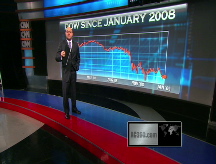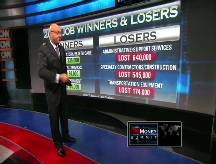Government debt prices fall
Treasurys under pressure amid Senate additions to stimulus and increased auctions of new issues.
NEW YORK (CNNMoney.com) -- The Treasury market wasn't able to turn its attention away from the avalanche of supply clogging up the pipelines.
Government debt prices rallied Friday and Monday, but by Tuesday, the potential volume of supply headed to market weighed on debt prices.
The Senate added $64 billion to the tab of the stimulus package and the Treasury announced Monday that its estimates of how much debt would be headed to market in the first quarter were low to the tune of $125 billion.
The Treasury is due to announce its quarterly refunding Wednesday. "The upcoming supply with the refunding announcement is going to be so large that the market needs to prepare to digest that," said Craig Ziegler, Treasury agency trader at Broadpoint Securities Group. "A lot of bonds are coming to market, and to make room for that supply, the market can be very hesitant to rally too much ahead of that."
Supply headed to market: Four times a year, the Treasury department makes an announcement outlining the government's plan for brining debt to market in the quarter. The quarterly refinance, which announces specific debt auctions with amounts and maturities, was due out Wednesday at 9 am ET.
On Monday, the Treasury said that it expects to borrow $493 billion of "marketable debt" in the first three months of the year - $125 billion more than it had originally expected.
In the April to June quarter, the Treasury said it expects to borrow $165 billion of "marketable debt." The release Monday said that Treasury borrowed $569 billion worth of marketable debt in the last three months of 2008.
In a statement for the Treasury Borrowing Advisory Committee, acting assistant secretary for economic policy Ralph M. Monaco said "measures to support the economy coupled with lower revenues as a consequence of the deficit are raising the deficit."
"The budget deficit will continue to grow in FY2009 as expenditures rise sharply and receipts are depressed by falling employment and income and declining asset values," said Monaco. "Outlays to support financial markets and stimulate the economy are expected to push the federal deficit to a record level in FY2009, both in absolute terms and as a share of GDP."
Senate's stimulus plan: The Obama administration has been lobbying hard to get a economic rescue package passed. The stimulus package is intended to spur the economy by building infrastructure and creating jobs.
The House of Representatives passed an $819 billion version of the bill last week, but when the stimulus proposal went to the Senate, it ballooned to $885 billion, according to an analysis released Monday by the Congressional Budget Office.
The federal budget deficit was already projected to top $1 trillion in fiscal 2009, and the Treasury market knows that the more the government looks to spend, the more debt will have to come to market.
Ziegler said that the stimulus bill was a longer term concern for the Treasury market than the refunding announcement. "It is overhanging, and it periodically has an affect, but there is a lot of back and forth in the Senate."
Another $64 billion worth of short term debt was set to go on the block this week, including $34 billion worth of 4-week bills Tuesday and $30 billion worth of 49-day cash management bills Wednesday. The government has already auctioned $58 billion worth of debt this week. Last week, the government sold $135 billion worth of debt, coming on the heels of $120 billion worth of debt brought to market the week before last.
Debt prices: The 10-year benchmark Treasury fell 31/32 to 107-27/32 and its yield rose to 2.83% from 2.72%. Bond prices and yields move in opposite directions.
The 30-year bond sank 2-7/32 to 116-17/32 and its yield rose to 3.59% from 3.48%. Meanwhile, the 2-year note dipped 3/32 to 99-28/32 and its yield rose to 0.94%.
The yield on the 3-month Treasury bill rose to 0.34%, higher than 0.26% the day before. The 3-month bill has been used as a short-term gauge of confidence in the marketplace, because investors tend to shuffle funds in and out of the bill as they assess risk in other places - the lower the yield, the more risk they see.
The Federal Reserve has become caught as its goals push debt prices, and yields, in opposite directions. Pumping the economy with stimulus, which is funded by issuing massive amounts of supply, pushes prices lower and yields higher. Meanwhile, conventional mortgage rates, among other borrowing rates, are tied to the yield on the 10-year Treasury note and so the Fed wants to keep yields low.
"It is definitely a battle," said Ziegler.
Lending: The Federal Reserve released a survey of the nation's banks Monday that showed that while the credit markets were still pretty tight, there were fewer banks that were ramping up their lending restrictions.
Nearly two thirds of the banks surveyed showed that they tightened lending standards on commercial and industrial loans in the last three months of the year, but that was down from 85% in the previous quarter, according to the Fed's report.
The 3-month Libor rate ticked up to 1.23% Tuesday from 1.22% the day prior, according to data available on Bloomberg.com. The overnight Libor rate rose to 0.31% from 0.28% Monday.
Libor, the London Interbank Offered Rate, is a daily average of rates that 16 different banks charge each other to lend money in London, and it is used to calculate adjustable-rate mortgages. More than $350 billion in assets are tied to Libor.
Two credit market gauges were mixed. The "TED" spread narrowed to 0.89 percentage points Tuesday from 0.96 percentage point Monday. The bigger the TED spread, the less willing investors are to take risks. The rate surged as the credit crisis gripped the economy, but it has since fallen off as central banks around the world have lowered interest rates and pumped liquidity into the economy.
Another market indicator, the Libor-OIS spread, widened to 0.98 percentage point Tuesday from 0.94 percentage point. The Libor-OIS spread measures how much cash is available for lending between banks and is used for determining lending rates. The bigger the spread, the less cash is available for lending. ![]()




